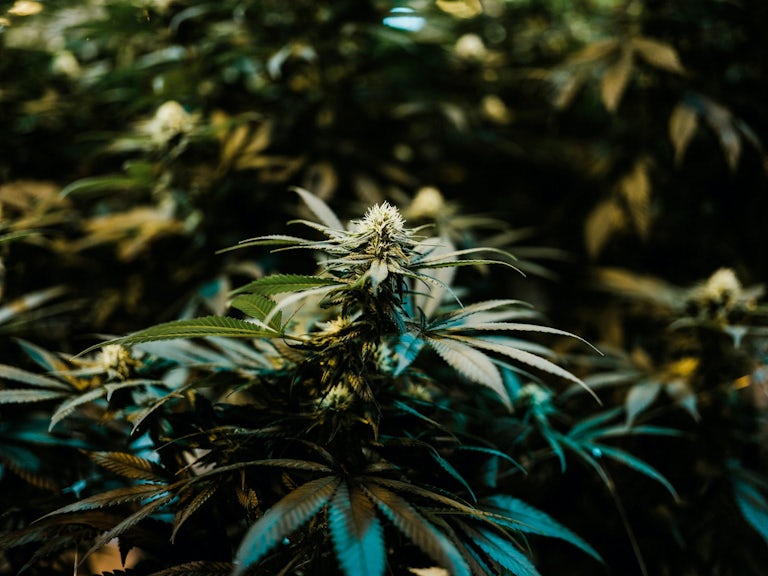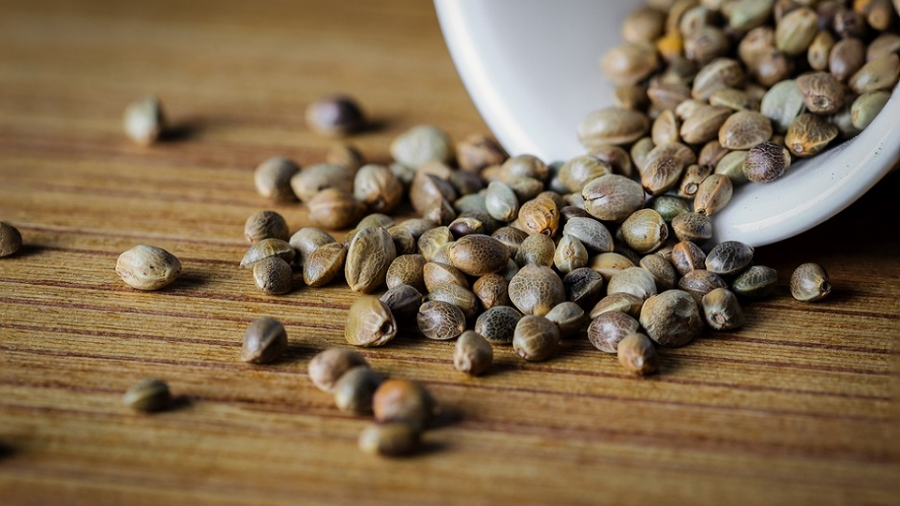Starting cannabis from seed can be extremely rewarding. Not only do you get to take your plants through a complete growth cycle, but you might also get to produce some seeds of your own. With seeds, anyone can go from a cannabis enthusiast to an amateur breeder.
You’ll be able to custom tailor your plants to meet your specific needs or possibly develop a new strain or two. To help you experience the wonders of seeds, we’ve created this article – the ultimate guide to growing cannabis seeds.
What Are Cannabis Seeds
Cannabis seeds are obviously the seeds of our favorite herb, but can you grow any old seed into a flowering weed plant? The important thing for successfully growing cannabis is to only cultivate female plants. Female plants will provide you with the highest quality flowers for smoking. However, those same female plants should be seedless, so where do cannabis seeds come from?
Cannabis seeds are produced when a male plant fertilizes a female plant. You don’t want this to happen if you’re growing females for smokable flower because then the buds are cluttered with seeds. That’s why cultivators isolate their female plants as soon as they identify the sex, and you should too.
Of course, if seeds are desirable for reproduction or hemp seed oil, then this process is allowed to happen. However, when it comes to creating cannabis seeds to produce a new generation of plants, there are some other techniques experienced cultivators will use.

How To Find And Choose The Right Cannabis Seeds
If you’re growing from a clone, it’s unlikely that your plant will produce seeds. Seeds develop after a male cannabis plant pollinates a female. Only female plants produce seeds. Yet, when you smoke cannabis, you’re typically smoking the unfertilized bud of the female flower. This can make it a bit difficult to actually find seeds if you’re interested in growing from scratch.
There are a couple of ways you can source your seeds. If you live in a legal medical or recreational state, ask your favorite dispensary for reputable local seed companies. Many people also order seeds from online seedbanks such as ILGM. Though, this is illegal in the United States. Seeds for “souvenir purposes” are legal in many regions around the world, allowing many seedbanks to ship worldwide.
Though ordering seeds is illegal in the U.S. and you can face criminal charges, seed arrests are uncommon in comparison to arrests from growing or germinating plants. It’s not uncommon, however, to have your mail-ordered seeds confiscated by U.S. customs. If you order seeds from an international seed bank and they are found, you will get a letter in the mail saying that your seeds have been tossed out.
Do All Cannabis Plants Produce Seeds?
Cannabis plants only produce seeds after a male plant pollinates a female plant. It’s uncommon to find seeds in dispensary quality bud, and it’s also unlikely that your plants will develop seeds if you’re growing from a clone. When you smoke or vape marijuana, you’re typically consuming the unpollinated, seedless female flower. This part of the plant is named sinsemilla, meaning “without seed”.
Female plants produce significantly more resin than male plants, which is why bud from female flowers is what we’ve come to cultivate for harvest. Marijuana resin in the form of trichomes produces has a crucial role in the plant’s reproductive cycle.
The trichome-heavy female marijuana bud is designed to capture male pollen spores in order to develop seeds and reproduce. When females are kept away from the males, not do you create sensimillia, but you also kickstart trichome production.
So, while all female plants are capable of producing seeds, pollination is required for their development. Breeders and seed banks play the part of geneticists and help spur evolution by selectively mixing pollen from specific male plants with the genes from selected female plants. This creates seeds featuring hand-selected and carefully chosen traits.
How To Choose Your Seeds
Look For These Traits
Finding seeds may be a little tricky, but choosing the right seeds to grow is easy. There are a few qualities that set good seeds apart. When you’re picking out your seeds, watch for these features:
- Color: Look for a dark brown teardrop-shaped seed. Some seeds have dark stripes or splotches of different brown, black, or tan shades. Avoid pale or green seeds.
- Size: Indicas produce larger seeds with striping. Sativa seeds are smaller and more uniform in color.
- Hardness: A good seed has a hard outer shell.Don’t pick seeds that are soft or damaged.
Select The Right Strain
Thanks to all of the innovative breeders out there, modern day marijuana has become a very diverse plant. You can find fast-growing varieties, varieties designed for perfect outdoor yields, and strains selectively bred to grow well indoors. Short, stocky indica plants are typically the best indoor choice. If you’d like a plant that grows to a manageable size but has more of a sativa high, you can find a balanced hybrid with ease.
Doing a little research ahead of time will help you avoid splurging on seeds that are difficult to grow in your intended environment. If you’re lucky enough to have a great outdoor grow space, a slower-growing sativa will make the best of the outdoor season.
Types Of Cannabis Seeds For Sale
You can order cannabis seeds online from seed banks, but it can get confusing with all the different types of seeds available. The first thing you want to do is decide which strain you want to grow. Most seed bank sites will have a selection, sometimes organized by indica, sativa, hybrid, high-CBD, or by their medical or recreational uses.
Feminized Seeds
The first category of cannabis seeds you’ll likely come across is “feminized seeds.” As you probably guessed, this is referring to the gender of the plant. While female plants are desired for growing smokable flower, there are pros and cons to feminized seeds.
The most obvious pro to growing weed from feminized seeds is getting a female plant. In fact, many breeders advertise having a “100 percent” success rate with their feminized cannabis seeds. This saves growers the time of identifying and separating male and female plants.
However, as experienced breeders are well aware, feminized seeds run the risk of developing into hermaphrodites. Female cannabis plants can form a hermaphrodite condition, where male flowers grow on the same plant, alongside female flowers, for a variety of reasons. But the biggest danger here is the male flowers self-pollinating the female flowers. All the resulting buds will be littered with seeds and not ideal for smoking.
At the same time, feminized seeds are an easy option for newbie growers and medical cannabis patients. Just be sure to keep an eye on those plants.
Auto-Flowering Seeds
The next term you’ll come across when shopping for weed seeds is “auto-flowering.” If you’re familiar with some cannabis cultivation basics, you know that the plant has a vegetative growth period and then switches into a “flowering” period where it grows the buds we know and love. What activates that switch is the change in light, from long days to shorter ones as would happen naturally when the seasons change from summer to fall.
In the spring, blue light wavelengths are more predominant. Plants rely on this blue light to prosper during vegetative growth. During the late summer and early autumn, red wavelengths of light from the sun become more abundant. This red light is packed with the energy the plant needs to develop complex flowers.
To flower photoperiod plants early, most indoor growers put the plants on a strict 12/12 light schedule. Meaning 12 hours under the lights followed by 12 hours of complete darkness.
Auto-flowering seeds, however, are different. Auto-flowering cannabis seeds don’t require a change in light to enter the flowering stage in their life cycle. They naturally begin flowering after a certain amount of time instead.
As a result, most auto-flowering plants are ready to harvest in under 10 weeks. Flowering often begins at a mere two to four weeks.

Cultivators developed these seeds by breeding regular high-THC Cannabis sativa with its very close relative Cannabis ruderalis. Cannabis ruderalis is a type of cannabis that grows in the wild. It’s typically smaller than Cannabis sativa and has a much lower THC count. However, when crossed with high-THC strains, breeders have developed auto-flowering plants with high THC counts that are low maintenance.
Though there is variation from strain to strain, auto-flowering strains tend to be much smaller than their standard counterparts. As a result, yields from auto-flowering plants tend to be slightly less. On the high end, some auto-flowering cannabis seeds can yield up to 150 grams per plant, though the average is somewhere in the double digits.
Auto-flowering seeds are particularly useful in northern climates, which have extremely long summer days. Once the nights become long enough to trigger flowering, the rain and frost soon follow.
This means that many plants fail to develop full flowers before the cold arrives.
Auto-flowering cannabis seeds also have some advantage indoors, especially for those who love sativas. Auto-flowering plants are generally small, compact, and can handle a wider range of grow environments.
Sativas, on the contrary, are tall plants with a long flowering period. Starting with auto-flowering, sativa seeds makes it easier to grow these wily plants indoors.
Most indica plants, however, are also short and perform well indoors regardless of whether or not you start with auto-flowering seeds.
Critics of auto-flowering seeds often find fault with the low yields of the plant. A photoperiod sensitive indica will produce short, manageable plants with a much higher yield than many auto-flowering varieties.
However, auto-flowering strains provide growers with the ability to produce extremely fast, easy to grow crops with excellent adaptations to the cold.

Hello. Thanks for good read. Can a male ever develop female buds in hermie? How long after flowering do you remove male? can it just grow beside the female? or do you have to remove it ?